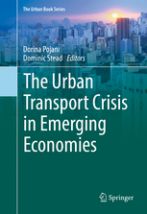The Urban Transport Crisis in Emerging Economies

This book examines urban transport in 12 countries (Brazil, China, Colombia, India, Indonesia, Iran, Mexico, Nigeria, Russia, South Africa, Turkey and Vietnam), each of which is allotted its own chapter. These fast-growing economies were chosen for their commonalities: all have large and young populations; all have large or rapidly growing cities; and all face negative consequences related to transport.
When it comes to urban transport challenges, there are other similarities across these cases:
· dynamic urban development
· extensive urban sprawl
· increasing social segregation
· increasing motorization
· inadequate public transport systems
· chaotic transport
· weak infrastructure for pedestrians and cyclists
· a minority of people who own cars
· informal, inefficient or corrupt planning systems.
While these challenges are not unique to emerging economies, they are especially serious in countries with limited financial and technical resources.
Further themes emerge when reading through the case studies. Inequality and government reluctance to challenge the status quo means that the wealthy drive at unsustainable levels in Brazil while the poor depend on unreliable bus systems, and in Mexico City access to new urban highways is limited to those who can afford the fees. Oil resources in both Iran and Nigeria have hampered the growth of alternatives to cars. And bus rapid transport has been successful in Brazilian, Colombian and Chinese cities.
Yet the unique context of each country means that solutions cannot be generic. Thus the authors discuss, for instance, possibilities for environmental planning in Brazil, investments in rail in China, motorcycle safety measures to reduce the high rate of traffic deaths in Vietnam, and extensions to cable car systems in Colombia that take into account the needs of low-income residents.
Together, these chapters call for integrated and inclusive approaches to urban transport, to avoid emerging economies going down the same path of heavy private vehicle dependence and inadequate planning that has affected many high-income countries.
Further reading:
Levy, Caren (2013), “Travel choice reframed: “deep distribution” and gender in urban transport”, Environment and Urbanization Vol 25, No 1, pages 47–63, available at http://journals.sagepub.com/doi/full/10.1177/0956247813477810.
Patel, Sheela and Kalpana Sharma (1998), “One David and three Goliaths: avoiding anti-poor solutions to Mumbai's transport problems”, Environment and Urbanization Vol 10, No 2, pages 149–159, available at http://journals.sagepub.com/doi/abs/10.1177/095624789801000205.
Tran, Hoai Anh and Ann Schlyter (2010), “Gender and class in urban transport: the cases of Xian and Hanoi”, Environment and Urbanization Vol 22, No 1, pages 139–155, available at http://journals.sagepub.com/doi/abs/10.1177/0956247810363526.
Urban Resource Centre (2001), “Urban poverty and transport: a case study from Karachi”, Environment and Urbanization Vol 13, No 1, pages 223–233, available at http://journals.sagepub.com/doi/abs/10.1177/095624780101300116.
Book note prepared by Christine Ro
Search the Book notes database
Our Book notes database contains details and summaries of all the publications included in Book notes since 1993 - with details on how to obtain/download.
Use the search form above, or visit the Book notes landing page for more options and latest content.
For a searchable database for papers in Environment and Urbanization, go to http://eau.sagepub.com/

